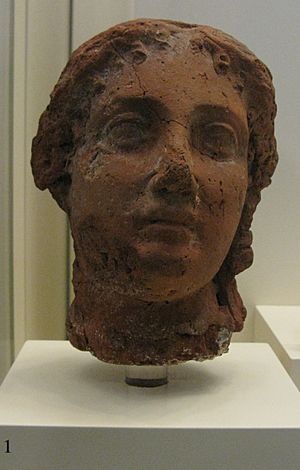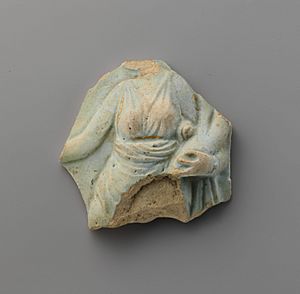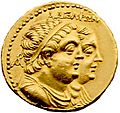Arsinoe II facts for kids
Quick facts for kids Arsinoe II Philadelphos |
|
|---|---|
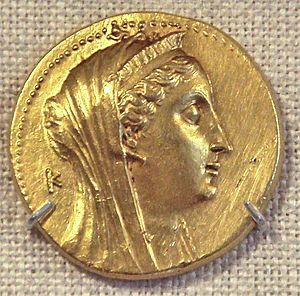 |
|
| Queen of the Ptolemaic Kingdom King of Upper and Lower Egypt |
|
| Reign | c. 277 – July 270 BC |
| Predecessor | Arsinoe I |
| Successor | Berenice II of Egypt |
| Died | 268 BC (?) |
| Spouse | Lysimachus Ptolemy Keraunos Ptolemy II Philadelphos |
| Issue | Ptolemy Epigonos Lysimachus (son of Lysimachus) Philip (son of Lysimachus) |
| Dynasty | Ptolemaic |
| Father | Ptolemy I Soter |
| Mother | Berenice I of Egypt |
Arsinoë II (born 316 BC – died between July 270 and 260 BC) was a powerful queen and co-ruler of the Ptolemaic Kingdom in ancient Egypt. She was even given the Egyptian title "King of Upper and Lower Egypt", which made her a pharaoh.
Arsinoë was also a queen in other lands. She became Queen of Thrace, Anatolia, and Macedonia through her marriage to King Lysimachus. Later, she became a co-ruler of the Ptolemaic Kingdom when she married her brother, Pharaoh Ptolemy II Philadelphus.
Contents
Life of a Queen
Growing Up
Arsinoë was the first daughter of Ptolemy I Soter, who founded the Greek-ruled state of Egypt. Her mother was Berenice I of Egypt.
She was probably born in Memphis, but she grew up in the new city of Alexandria. Her father had made Alexandria his capital city. We don't know much about her childhood or schooling. However, because she later supported scholars and was known for her own learning, it's believed she had an excellent education. Her brothers had famous teachers, and it's likely she joined their lessons. She even wrote to a scholar named Strato of Lampsacus later in her life.
Queen of Lysimachus
When Arsinoë was about 15 years old, she married King Lysimachus. He was around 60 at the time. They had three sons together: Ptolemy Epigonos, Lysimachus, and Philip.
To help her sons become next in line for the throne, Arsinoë was involved in a plan against Lysimachus's first son, Agathocles.
Arsinoë also paid for a special building at the Samothrace temple complex. She was likely a member of the religious group there.
Queen of Ptolemy Keraunos
In 281 BC, King Lysimachus died in a battle. Arsinoë then fled to a city called Cassandreia. There, she married her half-brother, Ptolemy Keraunos. Ptolemy Keraunos was a son of Ptolemy I Soter and his first wife. This marriage was for political reasons. Both Arsinoë and Ptolemy Keraunos wanted to rule Macedonia and Thrace. Their relationship was never good.
As Ptolemy Keraunos became more powerful, Arsinoë and her sons tried to gain more influence. This led to a conflict with Ptolemy Keraunos. Sadly, two of her sons, Lysimachus and Philip, died during this time. Her eldest son, Ptolemy, was able to escape and fled north.
Arsinoë found safety in the Samothrace temple complex, which she had supported earlier. She eventually left Samothrace and traveled to Alexandria, Egypt. She went there to seek protection from her full brother, Ptolemy II Philadelphus.
We don't know exactly when she arrived in Egypt. It might have been as early as 280 BC, right after her younger sons died. Or it could have been later, around 276 BC, when her eldest son's claim to the Macedonian throne failed.
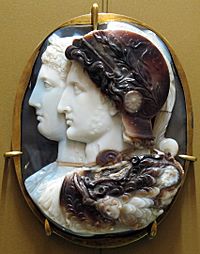
Queen of Egypt
Once in Egypt, it is believed that Arsinoë played a part in the divorce and exile of Arsinoe I, who was the wife of her younger brother, Ptolemy II. However, we don't know for sure if this is true. We also don't know when she arrived in Egypt, when Arsinoe I was exiled, or if the divorce happened without Arsinoë II's involvement.
After Ptolemy II divorced his wife, Arsinoë II married her brother. This was an unusual marriage for the time, but it was sometimes done in Egyptian royal families. Because of this marriage, both were given the special name "Philadelphoi," which means "Sibling-lovers." The exact reasons and details of their marriage are not fully known.
Arsinoë's role as queen was very important and set an example for future queens of the Ptolemaic dynasty. She appeared with her brother in public events and religious ceremonies. She also became a supporter of religion and learning. She was included in the Egyptian and Greek religious groups that her brother created for them. She shared all of her brother's royal titles and had a lot of influence. Towns were named after her, and she had her own religious group, as was common in Egypt. She also appeared on coins and helped with Egypt's foreign policy. She played a role in Ptolemy II's victory in the First Syrian War against the Seleucid Empire.
According to an ancient writer named Posidippus, Arsinoë won three chariot races at the famous Ancient Olympic Games. This likely happened in 272 BC.
Becoming a Goddess
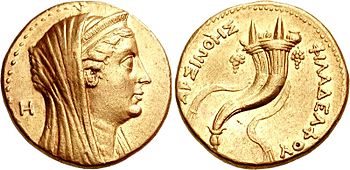
After Arsinoë II died, Ptolemy II created a special religious group to honor her, called the cult of Arsinoe Philadelphus. She was buried and given god-like honors in Mendes, where she had been a priestess. These ceremonies are remembered on a stone tablet called the Mendes stele. This stele also includes Ptolemy II's official announcement about her cult. All temples in Egypt had to place a statue of Arsinoë II next to the main god of their temple. In the artwork on the stele, Arsinoë is shown among the gods receiving offerings from Ptolemy. This image was seen all over Egypt.
Separate temples were also built for Arsinoë, including one in Memphis. The Fayyum region was even renamed the Arsinoite nome, with Arsinoë as its special goddess. Starting in 263 BC, a part of the tax on fruit and wine from each region of Egypt was used to pay for the local worship of Arsinoë.
Arsinoë's worship also spread in Alexandria. An annual religious role, called the Canephorus of Arsinoe Philadelphus, was created by 269 BC. The person holding this role was mentioned in all official documents for a long time. An annual parade was held to honor Arsinoë, led by the Canephorus. Every house along the parade route had to set up a small sand altar and offer birds and lentils to Arsinoë. A large temple was built for her near the harbor in Alexandria.
Admiral Callicrates of Samos built another special place of worship at Cape Zephyrium, at the eastern end of the harbor. There, Arsinoë was worshipped as Aphrodite Euploia, which means "Aphrodite of the good-sailing." Similar places were built in other port cities controlled by the Ptolemies, like Citium in Cyprus and Delos. Because of these places, Arsinoë became strongly linked to protecting sailors from shipwrecks. Coins and small statues showing the divine Arsinoë still exist today. Her special symbols are a small ram's horn behind her ear, which connects her to the ram of Mendes, and a pair of cornucopiae (horns of plenty) that she carries. She appears with these symbols on many faience oenochoae (jugs), which seem to have been used in burial ceremonies in Alexandria.
Arsinoë seems to have been a truly popular goddess throughout the Ptolemaic period. Both Greeks and Egyptians worshipped her, in Egypt and beyond. "Arsinoë" is one of the few Greek names that became a common Egyptian name during this time. Altars and dedication plaques in her honor are found all over Egypt and the Aegean Sea. Hundreds of her faience oenochoae have been found in the cemeteries of Alexandria.
Marriages and Children
Arsinoë married Lysimachus of Thrace in 300 or 299 BC. They had three children:
| Name | Born | Died | Notes |
|---|---|---|---|
| Ptolemy | 299/8 BC | February 240 BC | He was a co-ruler of Egypt with his uncle, Ptolemy II (267-259 BC). He later became a ruler of Telmessus. |
| Lysimachus | 297/6 BC | 279 BC | Died during a conflict with Ptolemy Keraunos. |
| Philip | 294 BC | 279 BC | Died during a conflict with Ptolemy Keraunos. |
After Lysimachus died in 281 BC, Arsinoë was briefly married to her half-brother Ptolemy Ceraunus from 280 to 279 BC. Then, she married her full-blooded, younger brother Ptolemy II of Egypt from the late 270s BC until her death. Ptolemy II's children from his first wife, Arsinoe I, including his future successor Ptolemy III, were later officially declared to be the children of Arsinoë II.
Images for kids
-
The Gonzaga Cameo in the Hermitage Museum, St. Petersburg; this ancient gem shows Ptolemy II and Arsinoe II.
-
Coin of Arsinoe II struck under the rule of her husband-brother Ptolemy II Philadelphus, showing her divine symbols: a ram's horn and a double cornucopia.
See also
 In Spanish: Arsínoe II para niños
In Spanish: Arsínoe II para niños


